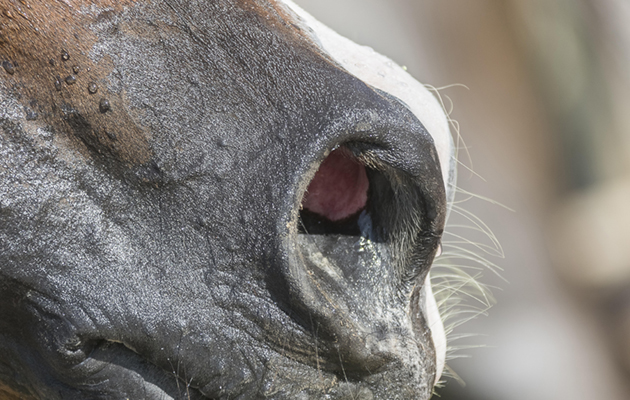Collapse of the larynx, a condition known as “roaring”, has been recognised in working horses for centuries.
Roaring is a particular problem in racehorses and sport horses because the collapsed larynx (voice box) prevents the horse getting enough air into his lungs during fast work and his performance therefore suffers.
The cause is a progressive degeneration of the nerve that supplies the muscles of the larynx. These muscles should open up the vocal cords as the horse breathes in, making the tunnel through the voice box as wide as possible. In affected horses, the muscles fail to pull the cords out of the airway and the horse has to breathe through a smaller gap.
The left side is far more frequently affected than the right, perhaps because the left nerve has a much longer route from the spinal cord to get to the larynx.
The disease has been given different names: “roaring” describes the noise an affected horse makes at exercise, as the floppy vocal cord vibrates in the airway during inspiration (inward breath), while French horsemen call it “sawing” because the sound resembles someone sawing a piece of wood. Laryngeal hemiplegia or laryngeal paralysis describe the effects of the condition on the larynx, but the current name, recurrent laryngeal neuropathy (RLN), accurately describes the root of the problem — damage to the nerve that makes the larynx work properly.
Big, deep-chested horses are most at risk; draught horses such as Shires and Percherons are typically affected, but are rarely required to work at high intensity. Racehorses, hunters and eventers are more likely to experience problems if they are affected.
Diagnosis is based upon a combination of signs: reduced performance during exercise, with or without the characteristic noise, palpable muscle loss on the larynx and, conclusively, examination of the larynx using a flexible endoscope.

A sticky situation
Over the years, a number of surgical operations have been devised to try to fix the problem.
In the early 20th century, Sir Frederick Hobday refined a surgical procedure in which the pocket of soft tissue behind the vocal cord is removed. When the surgical site heals, the scar tissue sticks the collapsed cord to the inside wall of the larynx and prevents it vibrating.
Hobday surgery tends to improve the noise a horse makes but does little to increase the size of the airway. These days, a vet performing a Hobday operation will often remove the vocal cord as well. Surgery will help mildly affected animals and can now be performed under standing sedation using a laser endoscope.
In the 1970s, a new technique was developed in which the withered laryngeal muscle was replaced by a prosthetic loop of permanent suture that was inserted into the top of the larynx. This procedure, termed prosthetic laryngoplasty but commonly called a “tie-back”, pulls the floppy vocal cord out of the way and opens up the larynx.
In combination with a Hobday-type procedure, it has become the standard surgery for RLN and improves performance in up to 70% of racehorses and up to 90% of eventers and hunters. It does have some drawbacks — not least that because the larynx cannot be properly closed during swallowing, horses treated using this technique sometimes develop problems caused by food entering the airway. Post-operative coughing is common.

Surgical solution
Because tie-back surgery has some problems, vets have continued to research ways to restore normal function to the larynx.
Highly complicated and delicate surgery was developed in the late 1980s and 1990s, in which a tissue graft, consisting of a small piece of one of the neck muscles with its own nerve attached, was transplanted into the larynx.
This nerve muscle pedicle graft operation requires a great deal of surgical skill and is only offered at elite specialist units.
Patients have to be on the operating table for a very long time and prolonged anaesthesia is, in itself, risky.
Surgeons based in France have just published the results of a new technique they have developed to treat RLN. Instead of trying to get a nerve and muscle graft to “take” and then grow on the larynx, they identified and carefully isolated small branches of the first cervical nerve near to the larynx that were supplying one of the midline muscles of the neck. They then simply transplanted the nerve into the existing, non-functioning muscle of the larynx.
The operation, performed on 17 affected horses, resulted in restored muscle activity in 11 out of 12 patients who were tested by nerve stimulation at their follow-up examination, and improved performance in nine out of 14 who were exercise tested.
Crucially, the surgery is far simpler than the nerve muscle graft technique and takes no longer to perform than a current tie-back.
Ref Horse & Hound; 20 September 2018